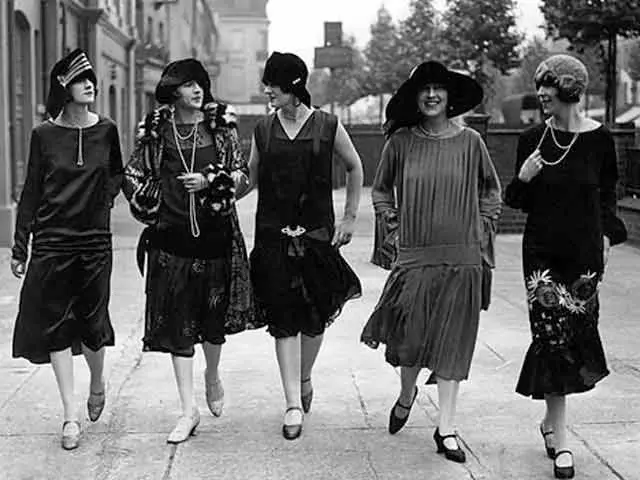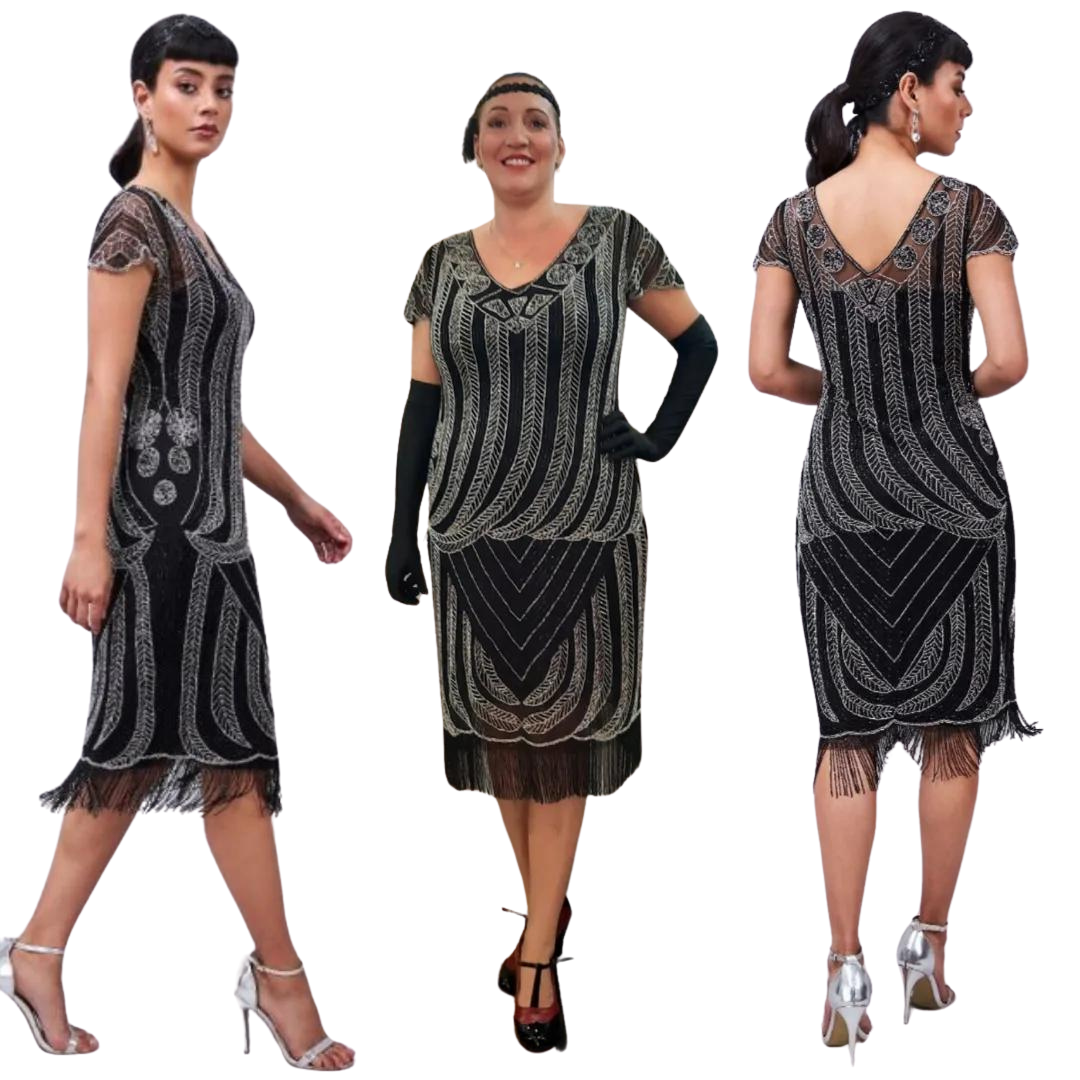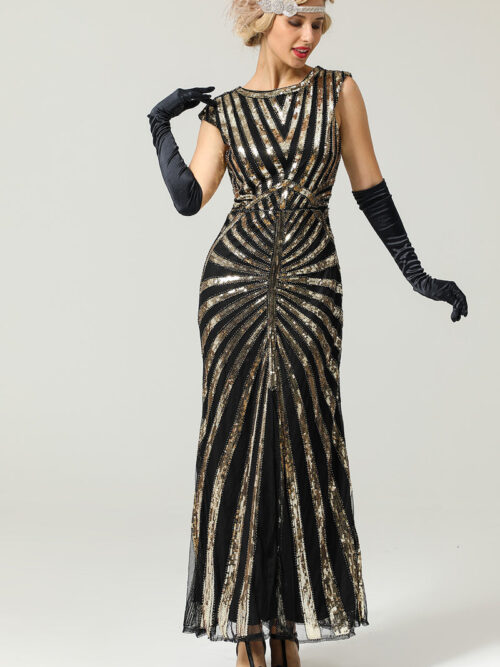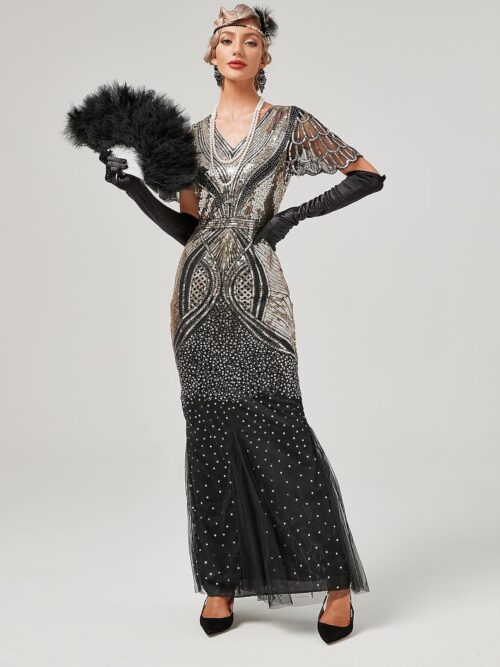1920s Fashion & Style Guide: How to Dress 20s Style
1920s Fashion Overview
Much like the transformative 1940s, the fashion of the 1920s also bore the imprints of societal changes following a devastating war. This particular era witnessed remarkable shifts, especially in terms of women’s roles after World War 1. These changes were clearly reflected in the way people dressed, as women began to discard the constricting corsets and opt for more comfortable and practical attire.
Delving into the annals of fashion history, we find that the evolution of 1920s fashion can be easily traced, yet it remains the most radical transformation. It marked a stark departure from the matronly aesthetic of the Edwardian Gibson girl, ushering in the dawn of the modern era as we know it today. Clothing no longer served solely as a status symbol for the affluent; it became a means of self-expression for individuals from various walks of life.
This was an era where vibrant cultural movements thrived in the bustling cities of the Western world, such as London’s decadent “bright young things” in high society or the soulful jazz scene in New Orleans.



A bit of history
Undeniably, the early part of the 20th century left a sombre mark on the majority of society. The profound impact of the First World War and the devastating outbreak of Spanish Influenza continue to reverberate through the years. Nonetheless, we must not overlook the monumental achievement of granting women the right to vote in 1919. Amidst the gloom, a fleeting period of prosperity emerged between the aftermath of World War I and the infamous crash of 1929. Dubbed the ‘roaring 20s’ in our present day, this era witnessed a whirlwind of change, especially evident in the realm of fashion and style.
As social structures faced challenges and industries underwent transformations, this evolution resonated within the realm of clothing and fashion. Additionally, the rise of silent movie stars and the advent of jazz from New Orleans marked the arrival of the vibrant jazz age.
During the 1920s, women experienced a newfound sense of freedom compared to their mothers, as they had tasted the liberating opportunities beyond domestic life that the war had presented. This newfound freedom manifested itself in their choice of clothing, which embraced simplicity and comfort.
The era witnessed a shift away from curves, with higher hemlines and a flatter silhouette, emphasising youthfulness. However, the impact of this era extended beyond mere fashion trends like cloche hats and drop waists; it was an explosion of change and a period of boundless experimentation.

The Flapper
The flapper, an embodiment of the unrestricted spirit of the 1920s, evoked a sense of shock and dismay among the older generations. Reckless, carefree, and brimming with boundless energy, these audacious women shattered societal norms with their daring fashion choices. With their short hair, high hemlines, and liberally applied makeup, they pushed the boundaries of what was considered appropriate attire.
These adventurous women were the very essence of the flapper movement. When one considers the quintessential flapper ensemble, the mind often conjures images of heavily adorned and beaded dresses, boasting daringly high hemlines and plunging necklines.
However, it would be remiss to pigeonhole the flapper style into a singular definition. The flapper was a woman who revelled in dancing and embraced the essence of a free spirit, and her choice of attire reflected this desire to stand out from the crowd. Such a diverse and dynamic movement could not possibly be defined by one particular style, for it encompassed a multitude of expressions and interpretations.
Chanel
Coco Chanel, a pioneer among women, bravely challenged societal norms by adopting trousers, cropped hair, and shunning the corset. Undoubtedly, Chanel stands as the paramount figure in 20th-century fashion, revolutionising the very essence of femininity with her trailblazing ideas.
By the late 1920s, she had solidified the foundation of modern women’s attire with her iconic three-piece ensemble: a pleated skirt, a cinched jumper, and a loosely tailored jacket. Moreover, she spearheaded the widespread admiration for the timeless little black dress, flawlessly complemented by opulent, oversized costume jewellery.



Art Deco
As we delve into the evolution of fashion in the 1920s, an intriguing correlation emerges between its progress and the flourishing Art Deco movement. These two artistic forces not only coexisted but also thrived off one another, fostering a mutually beneficial relationship. The minimalist silhouettes prevalent in 1920s fashion yearned for vibrant prints, which were generously supplied by the Art Deco movement.
Varying lengths and A-symmetry
The period in question exhibits a distinct characteristic of fluctuating dress lengths. Initially, due to the war, the hemlines were shortened and extended down to the ankle until the year 1923. However, there was a subsequent rise in hemlines up to the knee, which lasted until 1928.
Intriguingly, during this particular era, designers actively endeavoured to enhance the intricacy of their designs as a means to discourage imitation. This was accomplished through the addition of godets, flounce panels, and intricate cutting techniques.
Get the 1920s Look: our top 3 tips to get you started
Tip 1: The Foundation
Like any fashion trend, it is crucial to have the appropriate foundation garments (underwear) in place. However, when it comes to the 1920s style, there is no need to overly accentuate the waistline.
We can forgo the use of waspies or corsets that define the waist, opting instead for a more streamlined appearance. Similarly, there is no requirement to flatten the bosom, despite prevailing theories. In this era, soft and uncomplicated underwear, devoid of modern padding, is the preferred choice.
Tip 2: Accessories
During the 1920s, accessories took centre stage, embracing an array of fashionable elements. Women adorned themselves with elegant Cloche hats, adorned their hands with both long and short gloves, and indulged in an abundance of exquisite jewellery.
To complete their ensembles, some opted for the luxurious allure of faux fur, while others showcased their opulence with the authenticity of vintage pieces.
Tip 3: Hair and hats
During the 1920s, the prevalent hairstyle choice consisted primarily of bobbed hair, often cropped remarkably close to the head. Translating this vintage charm to contemporary hairdos may seem challenging, but fear not!
With a sprinkle of innovative techniques, achieving a 1920s-inspired look can be effortlessly accomplished. Stay tuned, as we will soon unveil a captivating video dedicated to the fabulous hairstyles of the roaring 20s.
-

Peacock Gatsby fringe dress in Green
£60.00 Select options This product has multiple variants. The options may be chosen on the product page -

Peacock Gatsby fringe dress in black
£60.00 Select options This product has multiple variants. The options may be chosen on the product page -

Valerie 1920’s Gatsby Flapper dress
£60.00 Select options This product has multiple variants. The options may be chosen on the product page -

Helena 1920’s Gatsby flapper dress in Green & Gold
£60.00 Select options This product has multiple variants. The options may be chosen on the product page -

Nicolette 1920’s Gatsby flapper dress in Black & Gold
£60.00 Select options This product has multiple variants. The options may be chosen on the product page -

Zelda 1920’s long Gatsby dress in Black & Gold
£70.00 Select options This product has multiple variants. The options may be chosen on the product page -

1920’s red Gatsby dress with sleeves
£60.00 Select options This product has multiple variants. The options may be chosen on the product page -

Helena 1920’s Gatsby dress in Black and Gold
£60.00 Select options This product has multiple variants. The options may be chosen on the product page -

Martha 1920’s long Gatsby flapper dress
£70.00 Select options This product has multiple variants. The options may be chosen on the product page -

Ginger 1920’s long evening dress
£75.00 Select options This product has multiple variants. The options may be chosen on the product page -

Caterina 1920’s dress in Black & Gold
£60.00 Select options This product has multiple variants. The options may be chosen on the product page
1920s Fashion Shopping List
Whether you are just after an evening dress for a speakeasy party or really wanting to try out a 1920s-influenced image, getting the 20s look is more difficult to recreate. But a few key garments will go a long way… (enough to get you started):
- a cloche hat
- Mary Jane shoes are easy to find and create a great look with coloured opaque tights.
- simple drop-waisted dress (which can then be adorned and styled according to where you are wearing it)
- Art deco jewellery: long beads (dare I say it?)
- a sumptuous long-line coat with a fur collar
Further Reading:
- 1920s Fashion: The Definitive Sourcebook
- Everyday Fashions of the 20s: Sears Catalogue
- Art Deco Fashion by Suzanne Lussier
